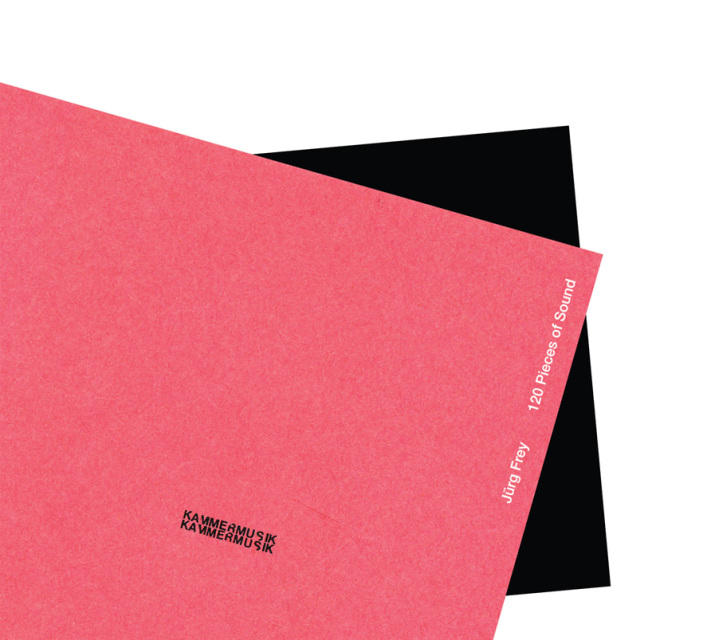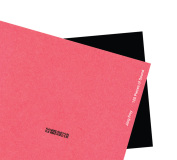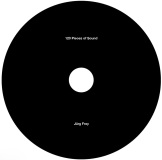- Laura Cetilia
- >
- Jürg Frey - 120 Pieces of Sound (CD)
Jürg Frey - 120 Pieces of Sound (CD)
SKU:
$14.00
$14.00
Unavailable
per item
elsewhere 003
This album '120 Pieces of Sound' contains two of Jürg Frey's significant compositions: 60 Pieces of Sound and L’âme est sans retenue II.
60 Pieces of Sound was composed by Jürg Frey in 2009 and performed by Jürg Frey and Ordinary Affects (Morgan Evans-Weiler, Luke Martin, Laura Cetilia, J.P.A. Falzone) at Wesleyan University, Middletown, CT on November 10, 2017. L’âme est sans retenue II was composed and edited by Jürg Frey for field recordings and bass clarinet in 1997-2000, with Frey on bass clarinet. Artwork by Jürg Frey, design by Yuko Zama. 4-panel gatefold wallet.
For lossless AIFF (16/44) file, go to this page.
For digital HD FLAC (24/96), go to this page.
|
TRACK LIST
1. 60 Pieces of Sound 32:00 2. L’âme est sans retenue II 40:03 (released October 10, 2018) CREDITS
TRACK 1: 60 Pieces of Sound (2009) 32:00 Ordinary Affects: Luke Martin - electric guitar Laura Cetilia - cello J.P.A. Falzone - keyboard Morgan Evans-Weiler - violin Jürg Frey - clarinet recorded by Luke Damrosch at Wesleyan University, Middletown, CT on November 10, 2017 mixed by Luke Damrosch and Jürg Frey mastered by Luke Damrosch TRACK 2: L’âme est sans retenue II (1997-2000) 40:03 for field recordings and bass clarinet Jürg Frey - field recordings, bass clarinet recorded by Fabio Oehrli at Tonlabor Bern, Bern, Switzerland on December 2012 mixed and mastered by Fabio Oehrli (Tonlabor Bern) cover artwork by Jürg Frey - Stück (1974) #29 design by Yuko Zama produced by Jürg Frey and Yuko Zama p+c 2018 elsewhere music |
Jürg Frey’s unique compositional approach places him at the cutting edge of contemporary classical music while simultaneously maintaining a touch of impressionistic/romantic aesthetics in its roots. Since the late 90's, Frey started to work with 'lists' as a basis of his compositions, sometimes words, sometimes chords, from which he developed and organized the musical materials. In recent years, Frey's focus on 'lists' has extended more toward the connections of items with each other, forming melodies.
Frey composed 60 Pieces of Sound in 2009, for an indefinite number of musicians; with two instruments that play the pitches as written in the score forming a two-part melody, and an open instrumentation part for any instrument(s) or sound maker(s) as 'the third voice.' Each of the 60 chords played by the ensemble is followed by a similar duration of silence. In November 2017, Frey and the Boston-based ensemble Ordinary Affects (Laura Cetilia, Morgan Evans-Weiler, J.P.A. Falzone, Luke Martin) performed '60 Pieces of Sound' as a part of their concert series in New England, and made a recording of this piece at Wesleyan University. In this recording, Frey's clarinet and Cetilia's cello played the pitches in the two-part melody while the rest played the open instrumentation part with undetermined sounds. The resulting music was a unique series of harmonies created by open instrumental sounds with a faintly recognizable melody hidden in the core of the ensemble's evenly tempered sounds. The impressions of the chords move along at the edge of consonance and dissonance with the afterglows of each chord in the subsequent silence, hovering somewhere between meditative calmness and disquieting shadow, while bringing an organic warmth and a feeling of breathable open air into a minimal musical structure. L’âme est sans retenue II was composed by Frey in 1997-2000, edited by him from the field recordings that Frey made in Berlin in 1997 with the addition of his bass clarinet sounds. It is the second piece of the series with the same title, after ‘L’âme est sans retenue I’ (ErstClass 002-5, 2017) and before ‘L’âme est sans retenue III’ (b-boim, 2008). Frey composed this series based on his list of ‘words’. The title of this composition series L’âme est sans retenue (“The soul is unrestrained”) is a quotation of a sentence from French poet and writer Edmond Jabès’s book ‘Désir d’un commencement, Angoisse d’une seule fin’ (Desire for a Beginning, Dread of One Single End). In this 40-minute piece 'L’âme est sans retenue II', the similar duration of the sounds and silences alternate with each other like in '60 Pieces of Sound’. For this piece, Frey first edited the field recording parts and later added his bass clarinet sound with a certain pitch to every part as an underlying tone that would blend with the field recordings. Frey's bass clarinet is discreet and almost unrecognizable here, often hidden under the complex layers of the field recordings, and yet clarifying the harmonization of the field recordings from inside. These two pieces were not actually directly connected to each other, but presenting these two pieces '60 Pieces of Sound' and 'L’âme est sans retenue II' back to back on this album brings out the fundamental aesthetic of Frey's compositions in regards to how he approaches the ‘harmonization’ and ‘openness’ of the music. REVIEWS
Front page review, Rate Your Music Very, very gradually evolving call-and-response music between a sparse few instruments and silence, creating something achingly beautiful and wistful. 60 Pieces of Sound is a revelation, reminding me of the reason why I explore the avant-garde; fascinating ideas executed so marvelously that it almost seems simple, almost obvious in retrospect. While giving off the appearance of being tense, it couldn't be further from the case. Each instrument sounds like it's longing for something out of grasp, everything combining into one beautiful texture as it yearns for more. The silence that answers is breathtaking and meditative, threatening to go on for longer but acquiescing to the rest of the chamber in the end and allowing the piece to grow off of it. Forgive me if I don't have the words to sufficiently describe this; to put it simply, I've never heard anything so captivating. L'âme est sans retenue II is more grounded, yet sonically seems to capture a more abstract feeling, as bass clarinet melds with field recordings in a way that allows them to be nearly indistinguishable in the best of ways; one element simply could not work without the other. The call-and-response style perfected on the first track is found here too, and while it possibly goes on a tad longer than necessary, it's no less striking. One could make the argument that what it's made up of makes it even more interesting, if anything. Endlessly replayable, soothing your heart every time. (4.50 stars Decibelle) (1/19/2020) Brian Olewnick, Just Outside One of those recordings, an exceedingly thoughtful and beautiful one, where describing the elements isn't difficult but getting across the effect on the listener seems next to impossible. There are two works presented here, structural cousins of each other, perhaps. The first, '60 Pieces of Sound' (2009), is performed by the ensemble Ordinary Affects (Laura Cetilla, cello; Morgan Evans-Weiler, violin; J.P.A. Falzone, keyboard; Luke Martin, electric guitar) joined by the composer on clarinet. I was fortunate enough to hear this group play this very piece in Boston about a year ago; I believe this recording was done just a few days afterward. There are indeed sixty sound elements: thirty tones played by the ensemble, each lasting about twenty seconds and thirty stretches of silence, each lasting about ten seconds, played alternately. That's it. But there's so much more. I gather, from having watched the fine, short documentary you can see about Frey (Part 1, Part 2) that the harmonies chosen were arrived at intuitively, in other words, what would sound appropriate after the one just played (and the silence). But the choices seem so right, so necessary. They inhabit a relatively narrow spectrum, but Frey discovers such a bounty of tones, relationships, subtle dynamic shifts, etc., that I simply sit in wonder. The unisons are tight but not overly so, like the ragged edge of good watercolor paper; the silences are full, often ending with indrawn breaths. I find myself constructing brief little shards of narrative between any two sound segments: a darker turn here, some hope there, a complication arising, etc. but any such turn very, very subtle. A truly living music. For 'L’âme est sans retenue II' (1997-2000), Frey once again uses periods of sound and silence, though their durations (over the course of forty minutes) vary. The sounds are field recordings made by Frey (as well as, per the credits, some bass clarinet, though I admit to having difficulty picking it up for certain; there are points where I think I hear it, if it's pitched fairly high), the silences are complete. There's an overall fine woolliness to the sounds. Sometimes, it seems as though the source is exterior, sometimes inside, here with a super-deep, rumbling bass spine, there with wispier elements, now and then with ghostly vestiges of what might be human voices. As with the previous work, the sounds occupt a territory that's roughly consistent--one gets the sense they could be excerpts from a single evening's work (they do connote nighttime to this listener), the recordist quietly ambling from location to location. Again, the shifts are discreet: a mild lessening or increase of dynamics, a slightly different timbre, slight in envelope but infinitely large in detail. Perhaps it's from the title ('The soul is without restraint') but there is, in fact, a sense of exposure, of opening oneself up to the world, pausing to consider what's been heard/seen (the silence), opening up again. So human. A wonderful recording, yet another in the seemingly (happily!) unending stream of such from Frey. (11/10/2018) Bill Meyer, Dusted Magazine People look for patterns in events; it’s just what our brains do. That human function both completes and connects the two compositions that comprise 120 Pieces of Sound. Swiss composer/clarinetist Jürg Frey began the process of conceiving “L’Âme Est Sans Retenue II” in 1997 when he made some field recordings in a Berlin park. Over time he arrived at a notion to divide the material into excerpted recordings interspersed by passages of silence. You might surmise from the numeral II that he made more than one composition from that material; this piece is the third to be released in a-chronological order since 2008. On “II,” unlike its predecessors, the six hour-long “L’Âme Est Sans Retenue I” (ErstClass, 2017) and the more manageable single-disc “L’Âme Est Sans Retenue III” (B-boim, 2008), Frey contributes sound as well as shape to the field recordings. He has tucked subliminal bass clarinet tones, which are often hard to pick out but which subtly harmonize with the essentially non-musical sound, into 30 discrete scraps of sound. The original recordings consist of natural outdoor sounds and distant human activity, some of it moderately distinct, some of it soft gray noise that seems to vibrate in time with Frey’s horn, a far-off automobile or some indiscernible city sound. In between the scraps are silences, which invite the listener to register sound event while limiting how much time they have to process it. Frey composed “60 Pieces of Sound” in 2009. Unlike “L’Âme Est Sans Retenue II” it is meant to be played by musicians, with two instrumental voices adhering to a scored melody while a third voice is asked to harmonize with them. The choice of how to do so is left open, with the caveat that the third party plays what they deem to be appropriate. For this version, which was recorded in 2017, Frey and cellist Laura Cetilia play the score. Violinist Morgan Evans-Weiler, keyboardist J.P.A. Falzone, and electric guitarist Luke Martin, who alongside Cetilia are members of the group Ordinary Affects, share the role of third voice. What makes this piece a natural counterpart on disc is that it is also broken into 30 sounds and 30 silences. The musicians creep through the piece one chord at a time, bounding each with quiet intakes of breath and a varying span of silence. The silences turn each chord into a discrete textural event much like the ones in the disc’s other piece. The events, of course, are quite different. Instead of soft gray noise, they are carefully polished episodes of harmony. The pacing of the piece fragments the melody so that it is not heard but is felt as an implied logic that is decoded by your brain’s determination to fill in the cracks. Situated on the same CD, the two compositions invite the listener to zero in on the details of each sound event. (12/10/2018) Michele Pallozo, Esoteros Rather than sisters, Erstwhile and Elsewhere are two “spouse” labels, just like their founders and artistic directors, Jon Abbey and Yuko Zama, have been for years. What unites them is a devout and sincere passion for the most radical areas of minimal composition and improvisation, as well as their coherence and a particular taste for an extremely accurate and detailed design. Elsewhere was founded in 2018, almost twenty years after the other, but despite being in the same vein it has already acquired its own graphic and stylistic identity with six publications dedicated to music of a deeply reflective and contemplative nature – including the latest glowing suite for solo piano by Melaine Dalibert. By virtue of a common sensitivity and direct proximity over the years to the Wandelweiser collective to which he belongs, Swiss composer Jürg Frey was an almost obvious choice for the catalog of Zama’s newborn label, whose “120 Pieces Of Sound” offers a significant corollary to the monumental Erstwhile edition of l’âme est sans retenue I (2017, ErstClass 002-5). Two more tracks, then, to investigate the fragile and mutable relationship between sound and silence – the latter continuing to prove impossible outside of its creation in the studio and the subsequent fixing inside the artificial and finite context of the physical support. “60 Pieces Of Sound” (2009), composed for an indefinite number of musicians, is performed here by Frey himself on clarinet with the American ensemble Ordinary Affects, in the form of a mixed quartet for viola, cello, keyboard and electric guitar. Every brief musical intervention, followed by a silence of roughly the same duration, sees the clarinet and the cello dictating a single sustained tone, to which the other members respond in unison, without the use of the vibrato, in indeterminate pitches; the fleeting and delicate harmonies seem to originate from nothingness, they sprout and withdraw effortlessly, like modest and totally distinct sound epiphanies. Each “piece” seems to abstract the last lines from a hidden larger composition, or the final verse of a poem we don’t need to read entirely to grasp its essence anyway, it being reduced to the minimum terms and encapsulated in an acoustic identity of a few seconds that, combined with a specular void, elevates its quiet lyricism by contrast. “l’âme est sans retenue II” (1997-2000) is in perfect continuity both with the first chapter of the series – of a total duration of six hours – and with the preceding work in this collection: if on the one hand, in fact, a regular alternation between minute sections of presence and absence of sound remains, on the other the concept of silence is again and more markedly problematized. The excerpts of field recordings that make up the single track are divided mainly between the immaculate airiness of open spaces and so-called ‘room tones’ (the continuous “buzzing” of rooms, often rendered perceptible only by the microphone filter itself); within these paintings, already close to the achrome, Frey intervened adding a tone of bass clarinet that almost completely merges with the faint surrounding soundscape. In this way the piece stimulates the sensory perception on several levels: the labile boundary between the manifestation of such “apparent voids” and the total absence of frequencies continually challenges us to readjust our auditory focus, paying a level of attention that the acoustic pollution of everyday life has gradually made us unaccustomed to. The radical art of Frey thus returns to open tiny windows through which we can rediscover our ability to discern and decode the most modest sound phenomena, furrows of existence subtracted from the second plane of sensitive experience and saved – in part, at least – from their extremely ephemeral nature. In this recent publication under the Elsewhere brand relives the fascinating oxymoron for which sound finds its ennobling through silence – be it real or approximated –, lapping on what could qualify as the most extreme frontier of today’s experimental composition. Outsiders by vocation, artists such as Jürg Frey will survive the judgment of time as the pioneers of a singular poetics of the essential, much more relevant than it appears today outside of its still narrow circuit. (12/29/2019) John Eyles, All About Jazz Although its proprietor Yuko Zama has been keen to stress that Elsewhere will be her label, independent of her husband Jon Abbey's Erstwhile label, for which she continues to work, this Jürg Frey release blurs the boundaries between the two labels somewhat. Frey has two previous releases on Erstwhile, notably the five-disc epic L'âme est sans Retenue (ErstClass, 2017) which consists entirely of the six-hour piece "L'âme est sans Retenue I"—the longest of Frey's career. It was constructed by Frey in 1997-98 from field recordings that he had made in a Berlin park earlier in 1997, interspersed with periods of silence. It had never been issued prior to the ErstClass album. Now, as one of its two tracks, 120 Pieces of Sound features "L'âme est sans Retenue II," which has a similar structure but only plays for forty minutes. Apart from their different durations, the only difference between the two is that the shorter one includes occasional subtle use of bass clarinet. Curiously, "L'âme est sans Retenue III," the sixty-six-minute third part of Frey's composition, was released back in 2008 on Radu Malfatti's B-Boim label, so anyone wishing to hear the complete work would need to acquire three separate albums on three different record labels. If that all sounds too complicated, rest assured that "L'âme est sans Retenue II" stands alone as a track in its own right and is a good way to sample the entire piece, particularly its contrasts between the mysterious, atmospheric field recordings and the silences which frame them. That track is only half the story of this album, though. Its other track, the 2009 composition "60 Pieces of Sound," is in total contrast, being performed by the quartet Ordinary Affects joined by Frey himself. The quartet's instrumentation of cello, electric guitar, keyboards and violin allied with Frey's clarinet produces a soundscape that is an ambiguous blend, with hints of a conventional string quartet shading into a more contemporary sound. As such, it is ideally equipped to give an engaging performance of the piece's sixty chords, punctuated by silences, a structure which complements that of the album's other track, giving the album a pleasing sense of symmetry. (12/7/2018) |




